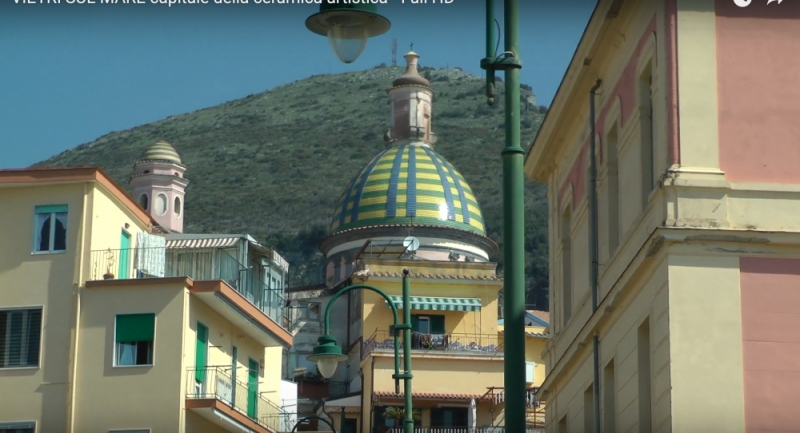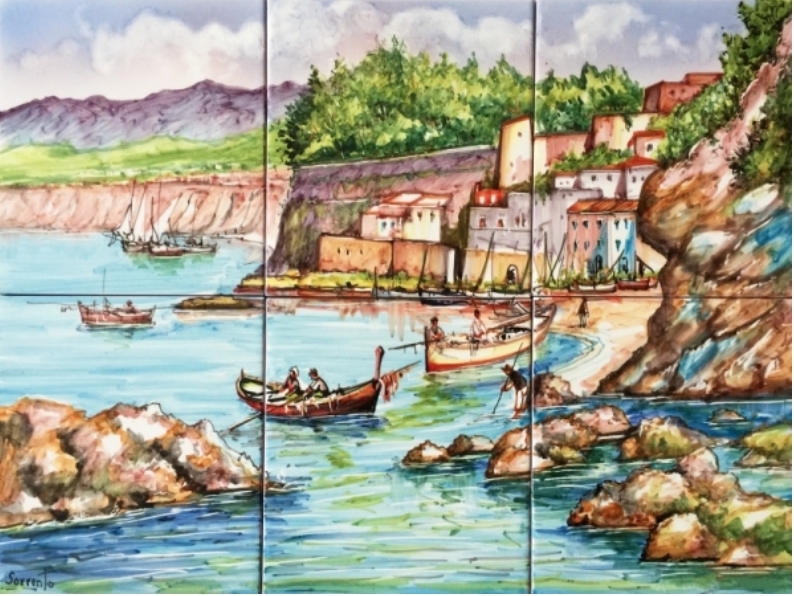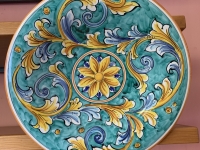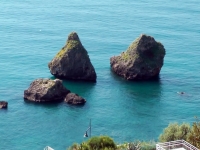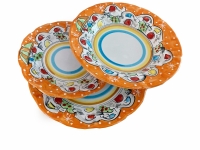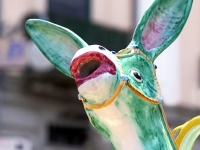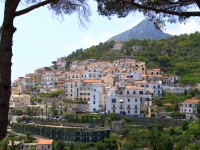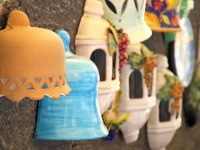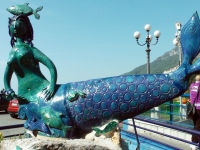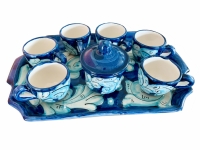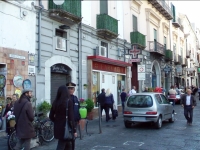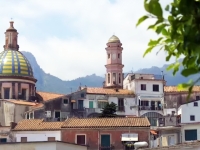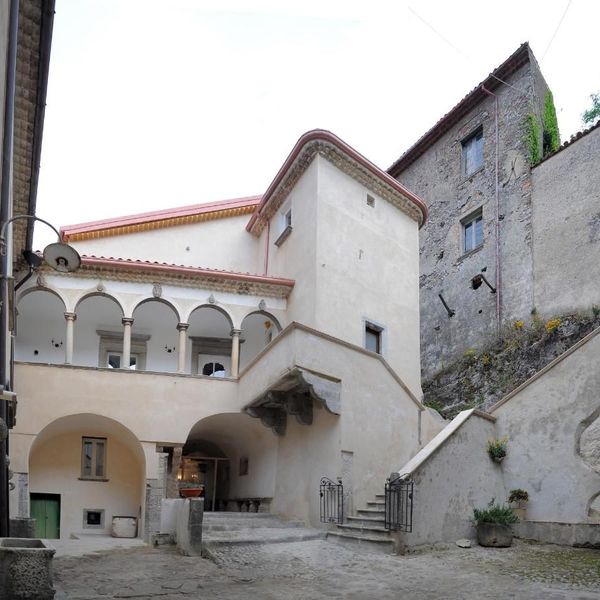Vietri and its origins
Vietri sul Mare , defined as a land of talents, art, creativity and colours, is one of the most important coastal villages of the Amalfi Coast and the province of Salerno, located in the most protected corner of the gulf of the same name. The origins of Vietri can be traced back to ancient Marcina, an Etruscan city, located where today is the Marina of Vietri, mentioned in the geography of Strambone with a predominantly mercantile function as a territory serving Nuceria. Renowned for wealth, elegance and luxury, Marcina, the classical ancestor of Vietri sul mare, was famous in ancient times for the cult of the arts and the development of maritime and land trade. At the turn of the year 1000, the territory, occupied by settlements scattered between Vietri, Marina di Vietri and Molina, was from an administrative point of view the outskirts of Salerno; in the Middle Ages it was entrusted to the Benedictine monastery of the SS. Trinità di Cava. From the Renaissance to the last century it was part of the city of Cava de' Tirreni and only in 1806 did it become an independent municipality. The town, in addition to offering a splendid sea, is surrounded by magnificent Mediterranean vegetation. Like all the towns on the Amalfi Coast, one of the most beautiful corners of paradise in the world certified by UNESCO with the World Heritage seal, Vietri sul Mare has a strong tourist vocation and is famous for its ceramic manufacturing. For those arriving from the sea, the spectacle of the majolica of the dome of the church of S. Giovanni Battista, the main city monument dating back to the seventeenth century, is the first impact with this ancient art which completely pervades the life, commerce and artisan activity of Vietri . News of a flourishing activity linked to the production of ceramics dates back to the 14th century as evidenced by the great demand for tiles and tiles produced in the nearby farmhouse of Vietri sul Mare by the master makers of that period. The growing commercial links combined with the unique characteristics of the territory and the particular originality of the Vietri artisans attracted, starting from the 1920s, the arrival on the coast of world-famous artists and artisans (Irene Kowaliska, Riccardo Dolker, Giovannino Carrano) which led Vietri to become one of the recognized capitals of the production of art ceramics. The ceramic workshops of Vietri are a show within a show. The narrow streets of the town are dotted with small shops and artisan workshops where the art of ceramics reaches truly unique levels, both in terms of shapes and colours. Every object and furnishing is reproduced in ceramic: tiles, plates, object holders, ashtrays, amphorae and ornaments of all types, vases, statuettes, tea and coffee services, sacred objects and the very famous donkeys. The donkeys, which later became the symbol of Vietri ceramics, are an 'invention' of German ceramists who moved to the charming coastal town between the 1920s and 1940s, attracted by the sun and the sea. Styles and contaminations are still proposed today. In the same way, however, we aspire to new experiences: from the classic warm tones of these places, we move on to glimpses of the village and scenes of daily life and imaginary and contemporary figures. These are the details that determine the strong personality of the inimitable Vietri Artistic Ceramics .
What see
Vietri sul Mare is the last of the Amalfi Coast countries to the south and is by right a part of the villages and towns that should be visited during our vacation. The parish church of San Giovanni Battista , built in the seventeenth century in Neapolitan late-Renaissance style, is characterized by the double crowning of the cusp of the bell tower in painted ceramics; the portal is surmounted by an oculus closed in the second half of the 20th century to insert a figure of the patron saint painted on ceramic. In the interior, with a single nave, the altars are decorated with majolica and ceramics except for the larger one, made of committed marble, interesting are the paintings that start from the seventeenth century and end at the eighteenth. Between the Dome and the tall bell tower rises Palazzo della Guardia, the Archconfraternity , which has a beautiful majolica floor. The palace is an example of that Baroque art also witnessed by the palaces of De Simone, Del Plato and Punzi.
Vietri sul Mare Arciconfraternita dell'Annunziata
and del Rosario
photo from lacongregaletteraria.com
and del Rosario
photo from lacongregaletteraria.com
Archconfraternity of the Annunciation and the Rosary
The Archconfraternity of the Annunciation and the Rosary , of seventeenth-century origin, is decorated on the façade with painted ceramics; the interior was frescoed in the 18th century. The Dragonea Tower of 1100. The Solimene ceramics factory is an example of organic architecture after the Second World War by Paolo Soleri; the interior contains a vast collection of contemporary ceramics. Church of the Madonna dell'Arco , on the street of the same name that joins Marina di Vietri sul Mare to the Amalfi Coast, on another narrow road that leads up to the hamlet of Raito. These streets retrace ancient paths that were used by the resident population to take refuge in the high areas of Vietri (the current villages of Raito and Albori) to defend themselves against attacks by the Saracens. The tower of Marina di Vietri is related to the defense. This, together with other similarly constructed towers, was the pirate ship sighting system. The sentries on top of the towers passed the signals with fires and fumes. Each tower could see the other. Don't miss a visit to the " Roman Baths " located along the banks of the Bonea stream , in the Bagnara area of Marina di Vietri. Some structures are located in the center of the village inside the "Vient 'e Mare" Restaurant where there is, well preserved, a circular room (open to the public) dated by the Superintendency, to the "1st century BC Wonderful to visit, because of its remarkable archaeological importance . The spa rooms are located in Via G. Pellegrino, 142.
Path of the Gods and Museum
Other places of interest are also the paths that connect the upper fractions of Raito and Albori with natural sources (Fonte del Cesare) and the upper fraction of Dragonea, with the Cava de 'Tirreni valley and the Badia . In this path we arrive at a fork that leads to the paths of the Avvocatella and the Avvocata. The latter is called " Sentiero degli Dei " because the views that can be enjoyed are incomparable. From the Avvocata path you reach Monte Pertuso, above Positano. The Ceramics Museum is located within the Villa Guariglia complex, the magnificent summer residence, bequest of the owner Raffaele Guariglia, Ambassador of Italy, of the Order of Malta and Foreign Minister of the Badoglio government.
Climate Curiosity Tips
climate: Vietri sul Mare rises directly on the sea and enjoys the classic Mediterranean climate and that is with a warm and temperate climate. The average temperature of the coldest month, January, stands at + 10.4 ° C; that of the hottest months, July and August, is around 26 ° C.
Curiosities: Vietri Sul Mare has about 8,000 residents and has been declared a World Heritage Site by UNESCO since 1997. The colors used for the enamels of Vietri ceramics? All are inspired by the colors of the Amalfi Coast, the deep blue of the sea, the bright green of the woods, the golden orange of the orange trees, the yellow of the Sorrento lemons, the ocher of the setting sun.
tips: if you visit the Amalfi coast, you must pay a visit to the village of Vietri Sul Mare. A village overlooking the sea where you can stroll through its narrow streets and go shopping in the many Vietri ceramics shops, while enjoying a good homemade ice cream or iced limoncello. If you have time, you can also visit a factory like that of the D'Arienzo family "La Vietrese" , which has been dirtying the hands with clay and the face of colors for 5 generations, handing down this ancient art from father to son. There you can, if you wish, also do a course in ceramics or decorum with one of these talented master potters. If, then, you love the Vietri ceramics, but you have no way to go there in person, you can then visit the website www.ceramicavietrese.it/en and buy and have it delivered directly to your home.


